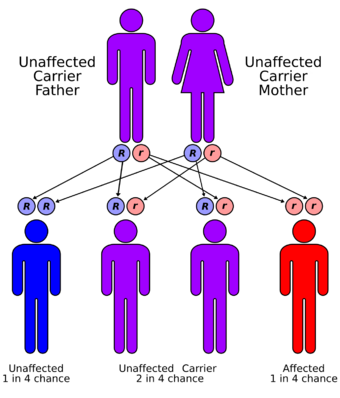Medicine:Harding ataxia
| Harding ataxia | |
|---|---|
| Other names | Early onset cerebellar ataxia with retained reflexes (EOCARR) |
 | |
| Harding ataxia has an autosomal recessive pattern of inheritance. | |
| Specialty | Neurology |
Harding ataxia is an autosomal recessive cerebellar ataxia originally described by Harding in 1981.[1] This form of cerebellar ataxia is similar to Friedreich ataxia including that it results in poor reflexes and balance, but differs in several ways, including the absence of diabetes mellitus, optic atrophy, cardiomyopathy, skeletal abnormalities, and the fact that tendon reflexes in the arms and knees remain intact.[2] This form of ataxia is characterized by onset in the first 20 years, and is less severe than Friedreich ataxia. Additional cases were diagnosed in 1989,[3] 1990,[4] 1991,[5] and 1998.[6]
Cases
40 cases were diagnosed in northern Italy between 1940 and 1990. The gene frequency for this autosomal recessive condition was estimated at 1 in 218.[7] In 1989, 16 cases on EOCA were diagnosed in children with a mean onset age of 7.1[3] In 1990, 20 patients affected by EOCA were studied. It was found that the ataxia of this study's participants affected the pyramidal tracts and peripheral nerves.[4]
Diagnosis
See also
- Cerebellar ataxia
- Friedreich ataxia
References
- ↑ Harding, A. E. (1981). "Early onset cerebellar ataxia with retained tendon reflexes: a clinical and genetic study of a disorder distinct from Friedreich's ataxia". Journal of Neurology, Neurosurgery, and Psychiatry 44 (6): 503–508. doi:10.1136/jnnp.44.6.503. PMID 7276963.
- ↑ Brusse, E.; Maat-Kievit, J.A.; van Swieten, J.C. (January 2007). "Diagnosis and management of early- and late-onset cerebellar ataxia". Clinical Genetics 71 (1): 12–24. doi:10.1111/j.1399-0004.2006.00722.x. PMID 17204042.
- ↑ 3.0 3.1 Ozeren, A.; Arac, N.; ulku, A. (December 1989). "Early-onset cerebellar ataxia with retained tendon reflexes". Acta Neurologica Scandinavica 80 (6): 593–597. doi:10.1111/j.1600-0404.1989.tb03933.x. PMID 2618587.
- ↑ 4.0 4.1 Filla et at. (1990). "Clinical and genetic heterogeneity in early onset cerebellar ataxia with retained tendon reflexes". Journal of Neurology, Neurosurgery, and Psychiatry 53 (8): 667–670. doi:10.1136/jnnp.53.8.667. PMID 2213043.
- ↑ Klockgether, T.; Petersen, D.; Grodd, W.; Dichgans, J. (1991). "Early onset cerebellar ataxia with retained tendon reflexes. Clinical, electrophysiological and MRI observations in comparison with Friedreich's ataxia.". Brain 114 (4): 1559–73. doi:10.1093/brain/114.4.1559. PMID 1884166.
- ↑ Mielke (July 1998). "Early-onset cerebellar ataxia (EOCA) with retained reflexes: reduced cerebellar benzodiazepine-receptor binding, progressive metabolic and cognitive impairment". Movement Disorders 13 (4): 739–745. doi:10.1002/mds.870130423. PMID 9686785.
- ↑ Chio (1993). "Early onset cerebellar ataxia with retained tendon reflexes: prevalence and gene frequency in an Italian population". Clinical Genetics 43 (4): 207–211. doi:10.1111/j.1399-0004.1993.tb04450.x. PMID 8330454.
External links
| Classification |
|---|
- Harding ataxia at the Office of Rare Diseases Research
 |

